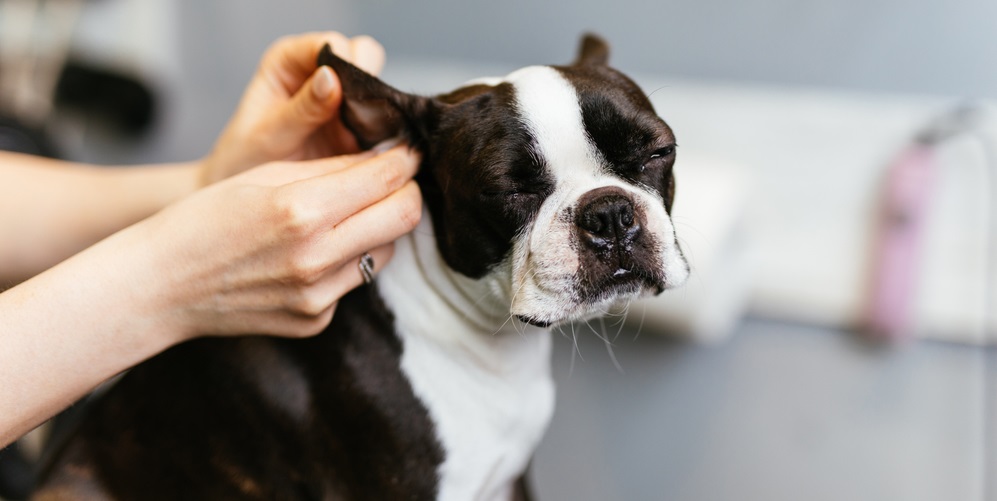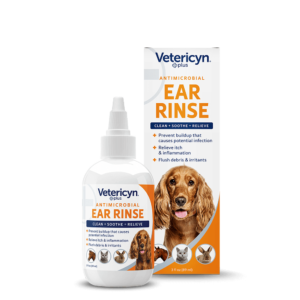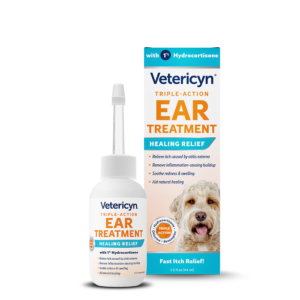Updated Aug 27, 2025
Ear infections are one of the most common medical ailments in dogs, and can be quite painful and uncomfortable for your pup.1
The unique structure of the canine ear makes them more vulnerable to otitis (ear infections) than humans. Their ear canals are hooked, resembling a J or an L-shape, which can easily harbor extra moisture and trap debris and bacteria.
Fortunately, recognizing dog ear infection symptoms, working with your veterinarian, and practicing proper ear care promote short and long-term pup ear health.
Healing Ear Infections in Dogs: Knowing the Signs
Before you can begin helping your dog heal from an ear infection, it’s important to recognize the signs:
- Excessive scratching, itching, or rubbing
- Frequently pawing at their ears or rubbing them against furniture
- Shaking or jerking their head
- Inflammation or redness
- Swelling, redness, and irritation around the ears
- Dog’s ears feel warm to the touch2
- Fluids or ear drainage (particularly in yellow, green, or black discharge) should always be taken as your cue to take your pup to the vet
- Crusting, scabs, or active bleeding
- Blood around your dog’s ear canal
- Scabbing
- Hair loss around the ear
If you see any abnormalities like these, it’s time to consult your vet for a full assessment. In long-term cases, additional symptoms may include:
- Abnormalities in balance, gait, and head tilt – The inner ear, for both dogs and humans, contains the vestibular system, which is critical for balance. When an infection affects the vestibular system, your dog may stumble, lose their balance, and have a head tilt.
- Problems eating – An inner ear infection may affect the nearby facial nerve, causing drooling, dropping food from the mouth, excessive blinking, dry eyes, and pupil size differences.3
The First Step to Healing Your Pet? Visiting the Vet
Most ear infections will not go away on their own and require clinical intervention.
Your vet will perform a deep ear cleaning on the affected ear, sometimes requiring sedation to clear the debris and infection in your dog’s ear. Your vet may also need to run some extra tests on your pet, including:
- Ear cytology – Looking at a sample of the ear discharge under a microscope to determine if bacteria or yeast are part of the problem.
- Culture or sensitivity testing – Evaluating the discharge to determine the specific type of bacteria present, and which antibiotics will work against them.
- Blood test – In some cases, ear infections are the result of an underlying health condition. Your vet may run a blood test to rule out endocrine diseases, allergies, and other issues that may underpin your dog’s ear infection.
- X-rays and scans – In severe cases of infection like otitis media and otitis interna, where the site of infection is in the middle or inner ear (respectively), your vet may need to perform an X-ray, CT scan, or MRI of your dog’s skull to view the entire ear anatomy.
The combination of an initial cleaning, otoscopic examination of the ear canal and eardrum, and these tests should be able to determine the underlying cause of your dog’s ear infection.4
How Your Vet Will Treat Your Dog’s Ear Infection
There are three main categories of treatment when it comes to treating your pet’s ear infection.
#1 Topical treatments
Cleansers, ointments, and ear drops are the go-to topical medications for ear infections, particularly in the case of otitis externa—the mildest kind of ear infection, affecting mainly the outer ear.
#2 Oral treatments
Oral treatments like steroids, antifungals, or antibiotics may be prescribed to kill microorganisms involved in the infection.
#3 Surgical treatments
Serious and deep-seated ear infections like otitis interna may require surgery to treat the infection and prevent recurrence.
In some instances, dogs who suffer from chronic ear infections may need a total ear canal ablation. In this case, your dog’s ear infections may be so severe that their ability to hear has already been compromised—ear canal ablation will not improve their hearing ability, but it will relieve them of pain and discomfort.5

Tending to Ear Infections in Dogs: Supportive At-Home Care
Never treat your dog’s ear infection without guidance from your veterinarian. Your veterinarian can determine the cause, severity, and appropriate course of action. Treatment without a veterinarian’s direction can be harmful to your dog.
If you’ve already talked to your vet, they should have given you instructions for treating your dog at home. The best way to stop ear infections from happening again is to get in the habit of cleaning your dog’s ears often and using the correct cleaning methods.
Here are our top recommendations for taking the best possible care of your dog’s ears at home:
Step 1: Choose the Right Solution
Always run topical products by your vet to determine whether they’re safe to use on your pet, especially if your dog has sustained physical damage to their ear canal. Never use hydrogen peroxide or products for humans or other animals as a cleaning solution for your dog —it can damage your dog’s ears and lead to the death of healthy cells and tissues.
For regular care, use a non-toxic, high-quality cleaning solution or ear rinse. Look for an ear cleaning solution that relieves itchiness, combats ear odors, and rids the ear of pathogens, pollutants, and foreign bodies causing ear distress. Vetericyn Plus Antimicrobial Ear Rinse removes foreign material from the ear, helps alleviate itch and irritation, and keeps the ear clean. It’s non-toxic formula won’t stain or burn and is safe if licked or ingested.
Step 2: Know Proper Cleaning Techniques
The correct technique will clear the infection quickly, minimize spreading, and avoid unnecessary trips to the vet’s office.
To clean your dog’s ears thoroughly, follow these five steps:
- Lift their ear so that you can see the entire ear canal.
- Gently apply the ear cleaning solution to the ear canal.
- Lower their ear flap to trap the solution in the ear canal and gently massage the outer ear. You should hear some squishing noises.
- Release the ear and allow your dog to shake its head to dislodge any debris from the ear canal.
- Wipe off any remaining residue.
- Give hugs and a treat.
Although your vet may use them, avoid putting Q-tips or cotton swabs into your dog’s ears. That could push the debris deeper or damage the ear canal.
Step 3: Don’t Slack on Ear Care
Some dog breeds are notoriously more susceptible to chronic ear infections because of their hair patterns, ear anatomy, or proneness to allergies and food sensitivities. The following breeds need extra attention when it comes to ear care:
- Cocker Spaniels and Springer Spaniels
- Labrador Retrievers and Golden Retrievers
- Poodles
- Schnauzers
- Shar-Peis
If your dog has long hair, long ears, or loves spending time swimming or bathing, it’s especially crucial to make regular and thorough ear cleaning a cornerstone of their care.
My Dog Seems to Keep Getting Ear Infections. What Can I Do?
If your dog is suffering from chronic ear infections, it’s all the more vital to collaborate with your vet for the best plan for your dog.
When dealt with poorly, ear infections may become resistant to antibiotics, making treatments less effective.4 Long-term ear infections can constrict the ear canal and cause scar tissue, which is painful and more challenging to treat.

Choose Vetericyn For Pet-Kind, Sustainable Wellness Solutions
Taking control of your pet’s at-home care now is the best way to ensure long-term health and well-being. Vetericyn’s range of pet and livestock wellness lines is endorsed—and used—by veterinarians worldwide.
Each of our pet-wellness tools is diligently researched and expertly designed, providing safe, effective, premium pet care from ears to hooves, to paws.
To learn more about dog ear infections and treatment, visit our blogs on Why You Should Clean Your Dog’s Ears and How To Clean Your Dog’s Eyes and Ears!
 Reviewed by Dr. Kathy Adamson
Reviewed by Dr. Kathy Adamson
Dr. Kathy Adamson earned her bachelor’s degree from the University of Notre Dame and her Doctor of Veterinary Medicine degree from the University of Wisconsin-Madison School of Veterinary Medicine.
She completed a one-year small animal medicine and surgery internship at the North Carolina State College of Veterinary Medicine. Alongside her studies, Kathy worked in a research lab, contributing as an author and co-author to various journal articles.
She has also pursued medical writing and editing certification through the University of Chicago Graham School. Currently, she runs KMA Veterinary & Medical Writing, a freelance medical writing company, serves as the Digital Content Manager for the Greater Chicago Area Chapter of the American Medical Writers Association, is a member of the AMWA Communications Committee, and enjoys writing about healthcare topics for people and their cherished pets.
![]() https://www.linkedin.com/in/kathyadamsondvm/
https://www.linkedin.com/in/kathyadamsondvm/
Sources:
- Fetch by WebMD. 6 Most Common Dog Health Problems. https://pets.webmd.com/dogs/6-most-common-dog-health-problems#1
- Embrace Pet Insurance. Top 5 Medical Conditions and Average Cost of Care. https://www.embracepetinsurance.com/about-us/press-media/press-release-detail/2019/01/10/top-dog-and-cat-claims-of-2018
- VCA. Inner Ear Infections (Otitis Interna) in Dogs. https://vcahospitals.com/know-your-pet/inner-ear-infection-otitis-interna-in-dogs
- PetMD. How to Identify, Treat, and Prevent Dog Ear Infections. https://www.petmd.com/dog/conditions/how-treat-and-prevent-dog-ear-infections#Go%20away
- Pet Health Network. Ear Infections in Dogs and Total Ear Canal Ablation (TECA). https://www.pethealthnetwork.com/dog-health/dog-surgery-a-z/ear-infections-dogs-and-total-ear-canal-ablation-teca


